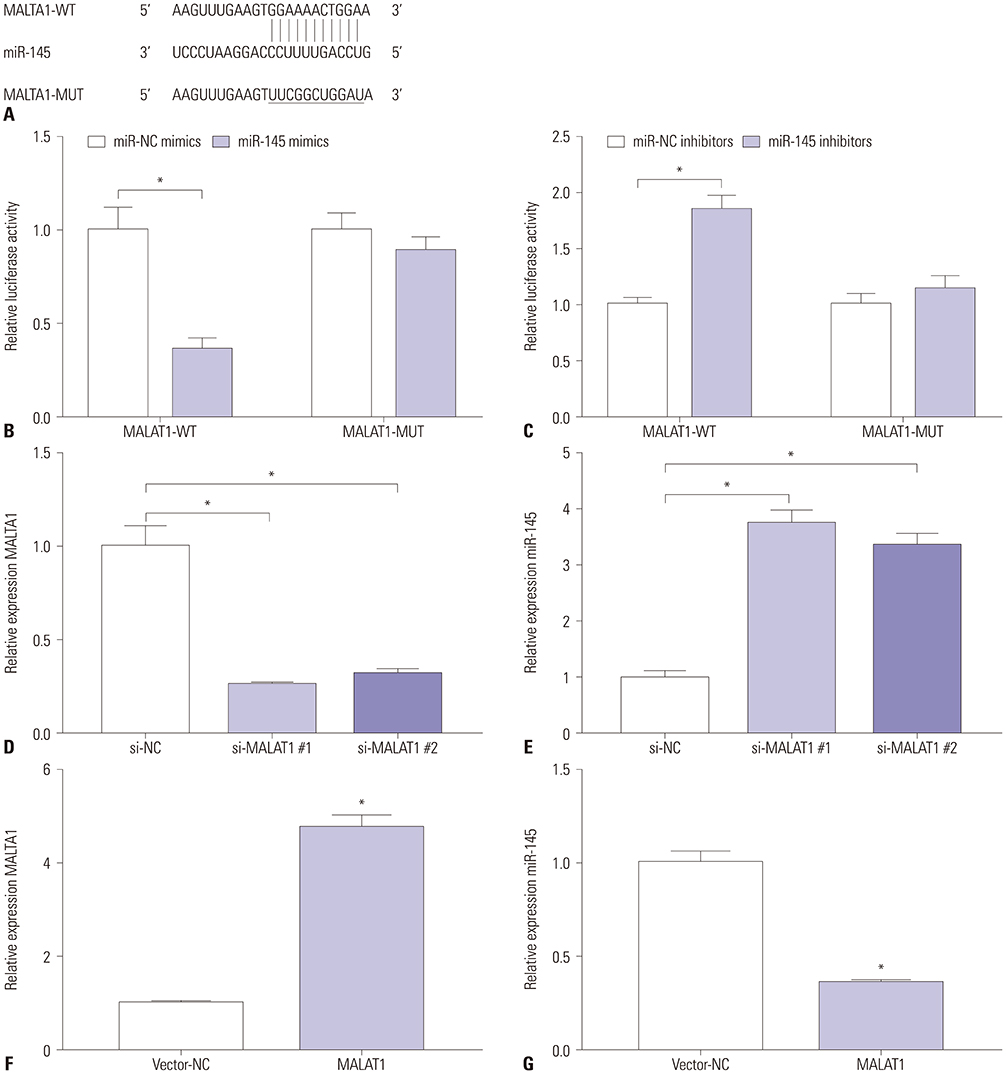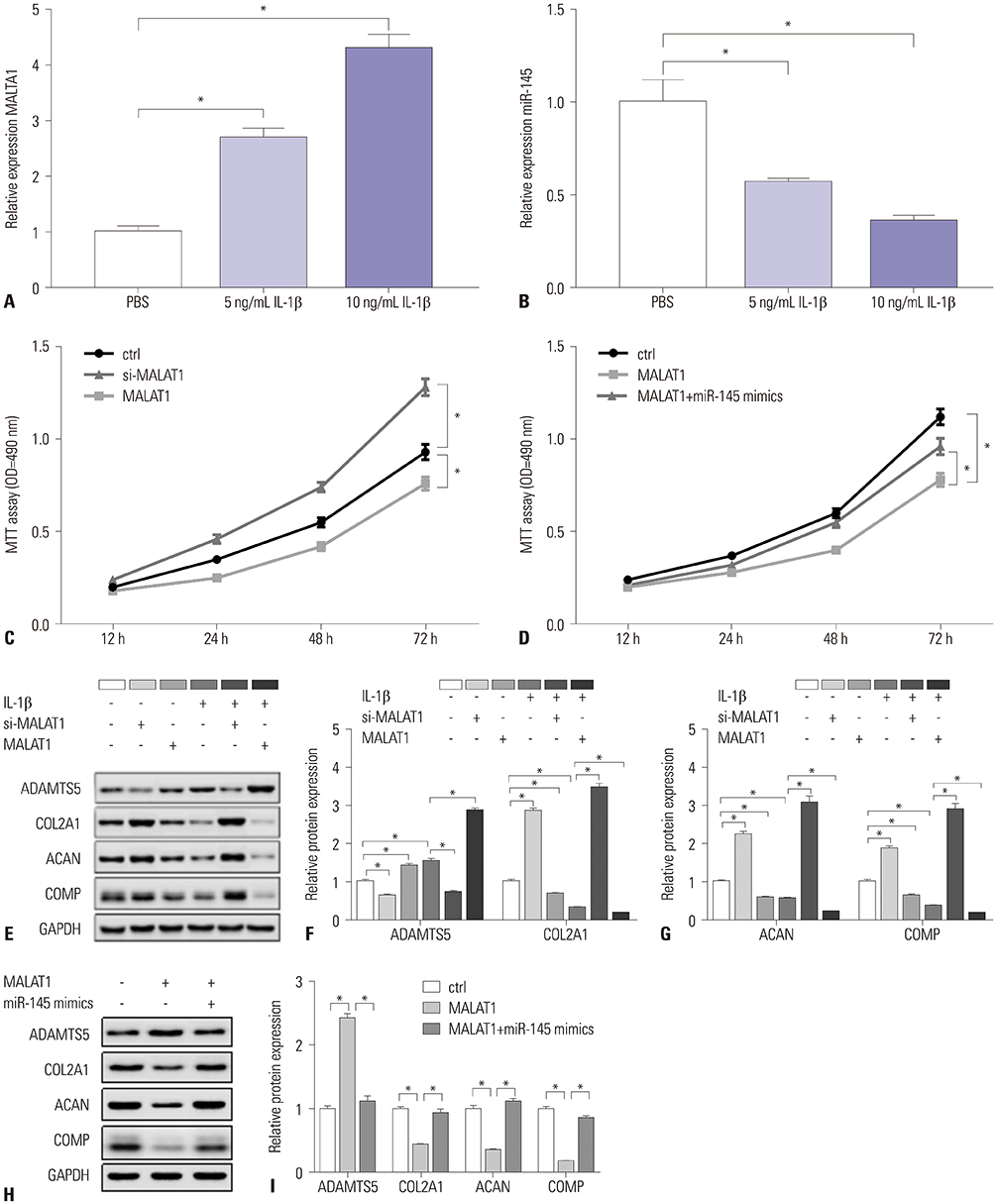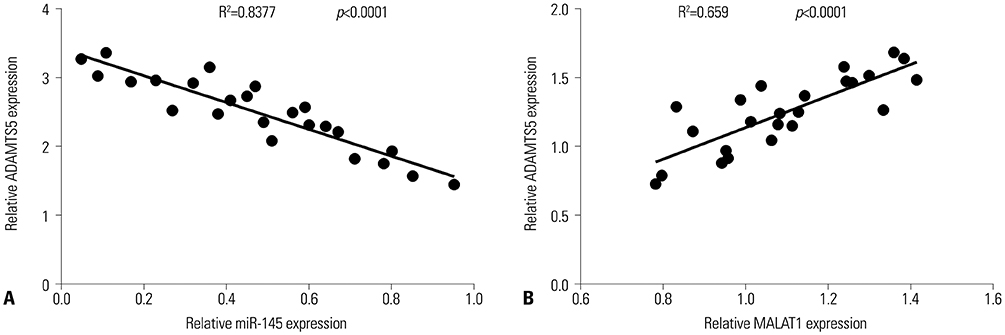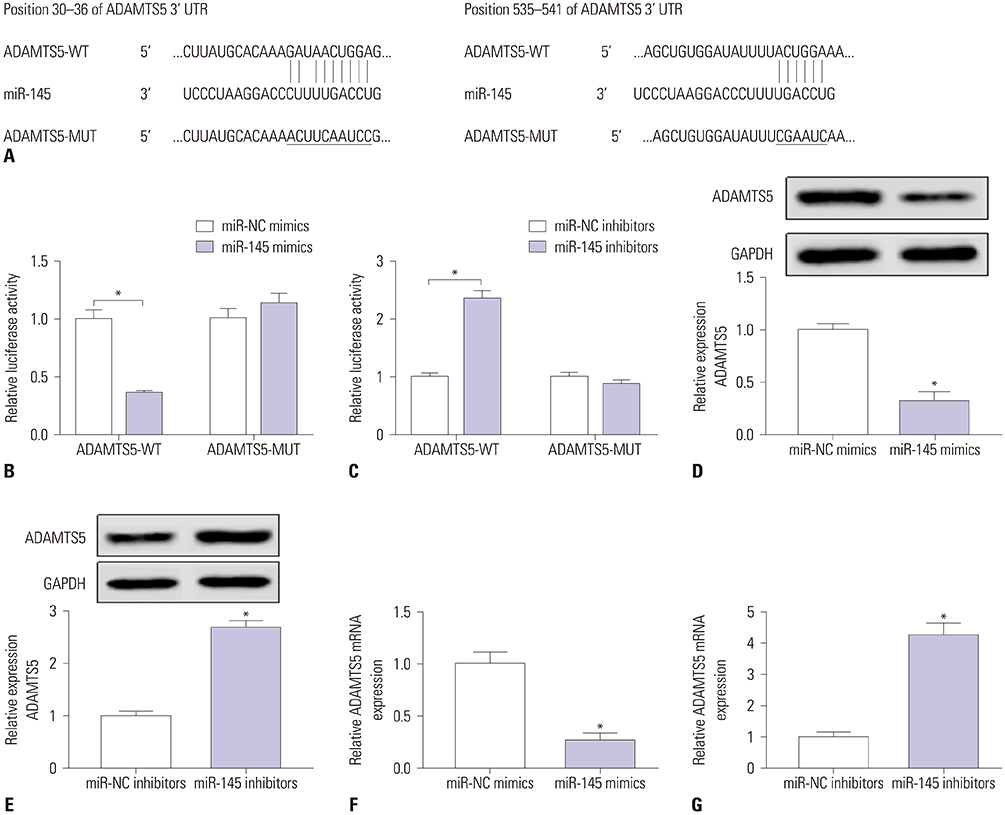Yonsei Med J.
2019 Nov;60(11):1081-1092. 10.3349/ymj.2019.60.11.1081.
LncRNA MALAT1/MiR-145 Adjusts IL-1β-Induced Chondrocytes Viability and Cartilage Matrix Degradation by Regulating ADAMTS5 in Human Osteoarthritis
- Affiliations
-
- 1Department of Bone and Joint Surgery, The Sixth People's Hospital of Ji'nan City (Zhangqiu People's Hospital affiliated to Jining Medical University), Shandong, China.
- 2Department of Dermatology, The Sixth People's Hospital of Ji'nan City (Zhangqiu People's Hospital affiliated to Jining Medical University), Shandong, China.
- 3Department of Orthopedics, the Forth Hospital of Yulin (Xingyuan Hospital), West Yulin, Shaanxi, China. rk6094246xiong@163.com
- KMID: 2460226
- DOI: http://doi.org/10.3349/ymj.2019.60.11.1081
Abstract
- PURPOSE
Accumulating evidence suggests that microRNA-145 (miR-145) plays an important role in osteoarthritis (OA), which is a chronic progressive joint disease. Long noncoding RNA metastasis-associated lung adenocarcinoma transcript 1 (MALAT1) promotes metastasis in cancers and functions as a sponge for miR-145. However, the role of MALAT1/miR-145 in OA pathogenesis has not yet been elucidated.
MATERIALS AND METHODS
The expression of MALAT1 and miR-145 was examined by quantitative real-time PCR; the interaction between miR-145, MALAT1 and a disintegrin and metalloproteinase with thrombospondin motifs (ADAMTS) 5 was verified by luciferase reporter assay. Correlations among MALAT1, miR-145, and ADAMTS5 were analyzed by Spearman rank analysis. Chondrocytes viability and cartilage extracellular matrix (ECM) degradation were investigated with cell viability assay and Western blotting analyzing expression of ADAMTS5, collagen type 2 alpha 1 (COL2A1), aggrecan (ACAN), and cartilage oligomeric matrix protein (COMP).
RESULTS
MALAT1 was upregulated, and miR-145 was downregulated in OA samples and IL-1β-induced chondrocytes. Mechanically, miR-145 could directly bind to MALAT1 and ADAMTS5. Moreover, miR-145 expression was negatively correlated with MALAT1 and ADAMTS5 expression in OA patients, whereas MALAT1 and ADAMTS5 expression was positively correlated. Functionally, overexpression of MALAT1 inhibited chondrocyte viability and promoted cartilage ECM degradation in IL-1β-induced chondrocytes. In support thereof, MALAT1 silencing and miR-145 upregulation exerted the opposite effect in IL-1β-induced chondrocytes. Moreover, the effect of MALAT1 was counteracted by miR-145 upregulation, and ADAMTS5 restoration could abate miR-145 effects.
CONCLUSION
An MALAT1/miR-145 axis contributes to ECM degradation in IL-1β-induced chondrocytes through targeting ADAMTS5, suggesting that MALAT1/miR-145/ADAMTS5 signaling may underlie human OA pathogenesis.
Keyword
MeSH Terms
-
Adenocarcinoma
Aggrecans
Blotting, Western
Cartilage Oligomeric Matrix Protein
Cartilage*
Cell Survival
Chondrocytes*
Collagen
Extracellular Matrix
Humans*
Joint Diseases
Luciferases
Lung
Neoplasm Metastasis
Osteoarthritis*
Porifera
Real-Time Polymerase Chain Reaction
RNA, Long Noncoding*
Temefos
Thrombospondins
Up-Regulation
Aggrecans
Collagen
Luciferases
RNA, Long Noncoding
Temefos
Thrombospondins
Figure
Reference
-
1. Peters AE, Akhtar R, Comerford EJ, Bates KT. The effect of ageing and osteoarthritis on the mechanical properties of cartilage and bone in the human knee joint. Sci Rep. 2018; 8:5931.
Article2. Zhao Y, Zhao J, Guo X, She J, Liu Y. Long non-coding RNA PVT1, a molecular sponge for miR-149, contributes aberrant metabolic dysfunction and inflammation in IL-1β-simulated osteoarthritic chondrocytes. Biosci Rep. 2018; 38:BSR20180576.
Article3. Akkiraju H, Nohe A. Role of chondrocytes in cartilage formation, progression of osteoarthritis and cartilage regeneration. J Dev Biol. 2015; 3:177–192.
Article4. Mead TJ, Apte SS. ADAMTS proteins in human disorders. Matrix Biol. 2018; 71-72:225–239.
Article5. Tío L, Martel-Pelletier J, Pelletier JP, Bishop PN, Roughley P, Farran A, et al. Characterization of opticin digestion by proteases involved in osteoarthritis development. Joint Bone Spine. 2014; 81:137–141.
Article6. Verma P, Dalal K. ADAMTS-4 and ADAMTS-5: key enzymes in osteoarthritis. J Cell Biochem. 2011; 112:3507–3514.
Article7. Ji Q, Xu X, Zhang Q, Kang L, Xu Y, Zhang K, et al. The IL-1β/AP-1/miR-30a/ADAMTS-5 axis regulates cartilage matrix degradation in human osteoarthritis. J Mol Med (Berl). 2016; 94:771–785.
Article8. Ji Q, Xu X, Xu Y, Fan Z, Kang L, Li L, et al. miR-105/Runx2 axis mediates FGF2-induced ADAMTS expression in osteoarthritis cartilage. J Mol Med (Berl). 2016; 94:681–694.
Article9. Fiorucci G, Chiantore MV, Mangino G, Percario ZA, Affabris E, Romeo G. Cancer regulator microRNA: potential relevance in diagnosis, prognosis and treatment of cancer. Curr Med Chem. 2012; 19:461–474.
Article10. Kuninty PR, Schnittert J, Storm G, Prakash J. MicroRNA targeting to modulate tumor microenvironment. Front Oncol. 2016; 6:3.
Article11. Nugent M. MicroRNAs: exploring new horizons in osteoarthritis. Osteoarthritis Cartilage. 2016; 24:573–580.
Article12. Cong L, Zhu Y, Tu G. A bioinformatic analysis of microRNAs role in osteoarthritis. Osteoarthritis Cartilage. 2017; 25:1362–1371.
Article13. Yang B, Kang X, Xing Y, Dou C, Kang F, Li J, et al. Effect of microRNA-145 on IL-1β-induced cartilage degradation in human chondrocytes. FEBS Lett. 2014; 588:2344–2352.
Article14. Hu G, Zhao X, Wang C, Geng Y, Zhao J, Xu J, et al. MicroRNA-145 attenuates TNF-α-driven cartilage matrix degradation in osteoarthritis via direct suppression of MKK4. Cell Death Dis. 2017; 8:e3140.
Article15. Martinez-Sanchez A, Dudek KA, Murphy CL. Regulation of human chondrocyte function through direct inhibition of cartilage master regulator SOX9 by microRNA-145 (miRNA-145). J Biol Chem. 2012; 287:916–924.
Article16. Wang GD, Zhao XW, Zhang YG, Kong Y, Niu SS, Ma LF, et al. Effects of miR-145 on the inhibition of chondrocyte proliferation and fibrosis by targeting TNFRSF11B in human osteoarthritis. Mol Med Rep. 2017; 15:75–80.
Article17. Song X, Cao G, Jing L, Lin S, Wang X, Zhang J, et al. Analysing the relationship between lncRNA and protein-coding gene and the role of lncRNA as ceRNA in pulmonary fibrosis. J Cell Mol Med. 2014; 18:991–1003.
Article18. Veneziano D, Di Bella S, Nigita G, Laganà A, Ferro A, Croce CM. Noncoding RNA: current deep sequencing data analysis approaches and challenges. Hum Mutat. 2016; 37:1283–1298.
Article19. Jiang SD, Lu J, Deng ZH, Li YS, Lei GH. Long noncoding RNAs in osteoarthritis. Joint Bone Spine. 2017; 84:553–556.
Article20. Marques-Rocha JL, Samblas M, Milagro FI, Bressan J, Martínez JA, Marti A. Noncoding RNAs, cytokines, and inflammation-related diseases. FASEB J. 2015; 29:3595–3611.
Article21. Messemaker TC, Frank-Bertoncelj M, Marques RB, Adriaans A, Bakker AM, Daha N, et al. A novel long non-coding RNA in the rheumatoid arthritis risk locus TRAF1-C5 influences C5 mRNA levels. Genes Immun. 2016; 17:85–92.
Article22. Ho J, Chan H, Wong SH, Wang MH, Yu J, Xiao Z, et al. The involvement of regulatory non-coding RNAs in sepsis: a systematic review. Crit Care. 2016; 20:383.
Article23. Yuan P, Cao W, Zang Q, Li G, Guo X, Fan J. The HIF-2α-MALAT1-miR-216b axis regulates multi-drug resistance of hepatocellular carcinoma cells via modulating autophagy. Biochem Biophys Res Commun. 2016; 478:1067–1073.
Article24. Lee NK, Lee JH, Ivan C, Ling H, Zhang X, Park CH, et al. MALAT1 promoted invasiveness of gastric adenocarcinoma. BMC Cancer. 2017; 17:46.
Article25. Uchida S, Dimmeler S. Long noncoding RNAs in cardiovascular diseases. Circ Res. 2015; 116:737–750.
Article26. Thum T, Fiedler J. LINCing MALAT1 and angiogenesis. Circ Res. 2014; 114:1366–1368.
Article27. Wang SH, Zhang WJ, Wu XC, Zhang MD, Weng MZ, Zhou D, et al. Long non-coding RNA Malat1 promotes gallbladder cancer development by acting as a molecular sponge to regulate miR-206. Oncotarget. 2016; 7:37857–37867.
Article28. Lu H, He Y, Lin L, Qi Z, Ma L, Li L, et al. Long non-coding RNA MALAT1 modulates radiosensitivity of HR-HPV+ cervical cancer via sponging miR-145. Tumour Biol. 2016; 37:1683–1691.
Article29. Xue D, Lu H, Xu HY, Zhou CX, He XZ. Long noncoding RNA MALAT1 enhances the docetaxel resistance of prostate cancer cells via miR-145-5p-mediated regulation of AKAP12. J Cell Mol Med. 2018; 22:3223–3237.
Article30. Zhao ZH, Hao W, Meng QT, Du XB, Lei SQ, Xia ZY. Long non-coding RNA MALAT1 functions as a mediator in cardioprotective effects of fentanyl in myocardial ischemia-reperfusion injury. Cell Biol Int. 2017; 41:62–70.
Article31. Xiang Y, Zhang Y, Tang Y, Li Q. MALAT1 modulates TGF-β1-induced endothelial-to-mesenchymal transition through downregulation of miR-145. Cell Physiol Biochem. 2017; 42:357–372.
Article32. Starodubtseva IA, Vasilieva LV, Nikitin AV. [Correction of an inflammatory process with an interleukin-1 inhibitor in the combination treatment of secondary osteoarthritis in the presence of comorbid condition]. Ter Arkh. 2015; 87:41–48.
Article33. Li X, Zhen Z, Tang G, Zheng C, Yang G. MiR-29a and MiR-140 protect chondrocytes against the anti-proliferation and cell matrix signaling changes by IL-1β. Mol Cells. 2016; 39:103–110.
Article34. Liu Q, Zhang X, Dai L, Hu X, Zhu J, Li L, et al. Long noncoding RNA related to cartilage injury promotes chondrocyte extracellular matrix degradation in osteoarthritis. Arthritis Rheumatol. 2014; 66:969–978.
Article35. Dou P, Hu R, Zhu W, Tang Q, Li D, Li H, et al. Long non-coding RNA HOTAIR promotes expression of ADAMTS-5 in human osteoarthritic articular chondrocytes. Pharmazie. 2017; 72:113–117.36. Wang SH, Zhang WJ, Wu XC, Weng MZ, Zhang MD, Cai Q, et al. The lncRNA MALAT1 functions as a competing endogenous RNA to regulate MCL-1 expression by sponging miR-363-3p in gallbladder cancer. J Cell Mol Med. 2016; 20:2299–2308.
Article37. Gao M, Miao L, Liu M, Li C, Yu C, Yan H, et al. miR-145 sensitizes breast cancer to doxorubicin by targeting multidrug resistance-associated protein-1. Oncotarget. 2016; 7:59714–59726.
Article38. Lu S, Xiao X, Cheng M. Matrine inhibits IL-1β-induced expression of matrix metalloproteinases by suppressing the activation of MAPK and NF-κB in human chondrocytes in vitro. Int J Clin Exp Pathol. 2015; 8:4764–4772.39. Brody JA, Grant MD. Age-associated diseases and conditions: implications for decreasing late life morbidity. Aging (Milano). 2001; 13:64–67.
Article40. Sun T, Yu J, Han L, Tian S, Xu B, Gong X, et al. Knockdown of long non-coding RNA RP11-445H22.4 alleviates LPS-induced injuries by regulation of MiR-301a in osteoarthritis. Cell Physiol Biochem. 2018; 45:832–843.
Article41. Shen H, Wang Y, Shi W, Sun G, Hong L, Zhang Y. LncRNA SNHG5/miR-26a/SOX2 signal axis enhances proliferation of chondrocyte in osteoarthritis. Acta Biochim Biophys Sin (Shanghai). 2018; 50:191–198.
Article42. Zhao Y, Xu J. Synovial fluid-derived exosomal lncRNA PCGEM1 as biomarker for the different stages of osteoarthritis. Int Orthop. 2018; 42:2865–2872.
Article43. Xia C, Liang S, He Z, Zhu X, Chen R, Chen J. Metformin, a first-line drug for type 2 diabetes mellitus, disrupts the MALAT1/miR-142-3p sponge to decrease invasion and migration in cervical cancer cells. Eur J Pharmacol. 2018; 830:59–67.
Article44. Ren L, Wei C, Li K, Lu Z. LncRNA MALAT1 up-regulates VEGF-A and ANGPT2 to promote angiogenesis in brain microvascular endothelial cells against oxygen-glucose deprivation via targetting miR-145. Biosci Rep. 2019; 39:BSR20180226.
Article45. Gu SX, Li X, Hamilton JL, Chee A, Kc R, Chen D, et al. MicroRNA-146a reduces IL-1 dependent inflammatory responses in the intervertebral disc. Gene. 2015; 555:80–87.
Article46. Vonk LA, Kragten AH, Dhert WJ, Saris DB, Creemers LB. Overexpression of hsa-miR-148a promotes cartilage production and inhibits cartilage degradation by osteoarthritic chondrocytes. Osteoarthritis Cartilage. 2014; 22:145–153.
Article47. Liu B, Qiang L, Wang GD, Duan Q, Liu J. LncRNA MALAT1 facilities high glucose induced endothelial to mesenchymal transition and fibrosis via targeting miR-145/ZEB2 axis. Eur Rev Med Pharmacol Sci. 2019; 23:3478–3486.48. Huang S, Zhang L, Song J, Wang Z, Huang X, Guo Z, et al. Long noncoding RNA MALAT1 mediates cardiac fibrosis in experimental postinfarct myocardium mice model. J Cell Physiol. 2019; 234:2997–3006.
Article49. Tian W, Du Y, Ma Y, Gu L, Zhou J, Deng D. MALAT1-miR663a negative feedback loop in colon cancer cell functions through direct miRNA-lncRNA binding. Cell Death Dis. 2018; 9:857.
Article50. Tao F, Tian X, Ruan S, Shen M, Zhang Z. miR-211 sponges lncRNA MALAT1 to suppress tumor growth and progression through inhibiting PHF19 in ovarian carcinoma. FASEB J. 2018; 32:fj201800495RR.
Article51. Hong BK, You S, Yoo SA, Park D, Hwang D, Cho CS, et al. MicroRNA-143 and -145 modulate the phenotype of synovial fibroblasts in rheumatoid arthritis. Exp Mol Med. 2017; 49:e363.
Article52. Li S, Sun W, Zheng H, Tian F. Microrna-145 accelerates the inflammatory reaction through activation of NF-κB signaling in atherosclerosis cells and mice. Biomed Pharmacother. 2018; 103:851–857.
Article53. Medvedeva EV, Grebenik EA, Gornostaeva SN, Telpuhov VI, Lychagin AV, Timashev PS, et al. Repair of damaged articular cartilage: current approaches and future directions. Int J Mol Sci. 2018; 19:E2366.
Article54. Liang S, Gong X, Zhang G, Huang G, Lu Y, Li Y. The lncRNA XIST interacts with miR-140/miR-124/iASPP axis to promote pancreatic carcinoma growth. Oncotarget. 2017; 8:113701–113718.
Article
- Full Text Links
- Actions
-
Cited
- CITED
-
- Close
- Share
- Similar articles
-
- miR-139 modulates MCPIP1/IL-6 expression and induces apoptosis in human OA chondrocytes
- Compound K Inhibits Interleukin-1β-induced Expression of Inflammatory Mediators and Matrix Metalloproteinases by Inhibiting Mitogen-activated Protein Kinase Activation in Chondrocytes
- Effects of gangliosides from deer bone extract on the gene expressions of matrix metalloproteinases and collagen type II in interleukin-1β-induced osteoarthritic chondrocytes
- Inhibition of the IL-1beta-induced Expression of Matrix Metalloproteinases by Controlled Release of IL-1 Receptor Antagonist Using Injectable and Thermo-reversible Gels in Human Osteoarthritis Chondrocytes
- Exosomes-Shuttled lncRNA SNHG7 by Bone Marrow Mesenchymal Stem Cells Alleviates Osteoarthritis Through Targeting miR-485-5p/FSP1 Axis-Mediated Chondrocytes Ferroptosis and Inflammation







